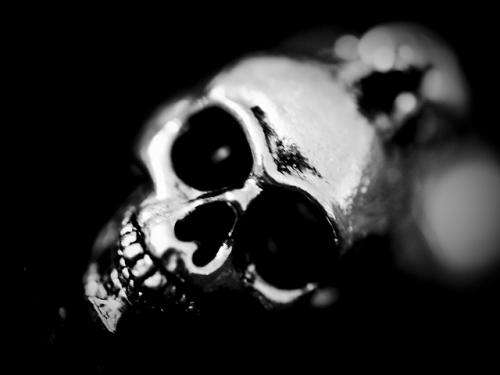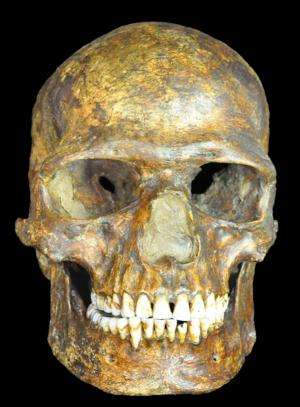Ancient DNA sheds light on the origin of Europeans

Much of the evidence of where the first Europeans came from was originally derived from comparisons of skulls but our work looking at ancient DNA is revealing new insight, with results published this month in Science.
Before we go any further, we need to look at what the skulls were telling us. Over a number of decades from the 1970s the US physical anthropologist William Howells recorded tens of thousands of human skulls held in museum collections across the world.
The patterns identified by Howells established that there were distinct correlations between geography and human biology, which provided insights into our understanding of the population history of the world.
In 1989 Howells included a number of fossil human skulls in this comparison to see if they could shed insights into the understanding of modern human dispersals.
Are the first Australians and Europeans related?
One of the patterns to emerge was that many of the earliest European modern human skulls from the last Ice Age, commonly referred to as the Cro-Magnon people, sat statistically very close to Aboriginal Australians and Papua New Guineans.
Did this reflect a close common origin between the first Europeans and the first Australians? Our research, led by Eske Willerslev from the University of Copenhagen, reveals the answer to this is "not really".
The genome recovered from an ancient skeleton, from a site known as Kostenki 14, has revealed an important story about the human history of Europe.
The remains there, found in 1954 at Kostenki, in south western Russia, were from a short, dark-skinned man who lived between 38,700 to 36,200 years ago.
It is generally accepted today that multivariate analyses comparing ancient and modern skulls do not necessarily indicate a stronger biological relationship between similarly looking skulls.
Instead it reflects such things as the kinds of patterns that we see in many early modern human fossils that are comparatively large and robust, when compared to later Holocene populations.

The story from ancient DNA is, however, far more complex.
Among the remains from the very ancient Russian, from Kostenki 14, is one of the earliest and most complete modern human skulls from Europe.
In Howells' original multivariate analysis the skull sat statistically very closely to the first Australians, but his DNA tells a very different story.
Our study shows that Kostenki 14 shared genetic ancestry with hunter-gatherers in Europe, as well as with the early farmers, suggesting that his ancestors interbred with members of the same Middle Eastern population who later turned into farmers and came to Europe themselves.
This lead Eske Willerslev to remark: "Kostenki was already pure European."
Out of Africa
All modern humans (Russians and Australians included) are derived from an initial migration out of Africa. From the fossil record this seems to have occurred sometime around 100,000 years ago in the Near East, at Skhul and Qafzeh.
This initial Homo sapiens range expansion from Africa was initially thought to have been short-lived, with Homo neanderthalensis returning to South West Asia some 60,000 years ago.
Apart from what his genome tells us about European origins, the Kostenki 14 genome is also fascinating because it contains the genetic record of a period shortly after the ancestors of Europeans hybridised with Neanderthals.
We now know that humans and Neanderthals mixed early in human history, sometime before 45,000 years ago. This is shown by the fact that the genome of Kostenki 14 had slightly more Neanderthal DNA than do Europeans and Asians today, perhaps as much as 1% more.
And his DNA comprises long tracts of Neanderthal DNA, much longer than that found in many non-African people now. In fact the longest of these totals about 3 million base pairs.
After the period of ancient hybridisation, these long DNA sequences start to be broken up by the processes of sexual reproduction. But Kostenki 14 has these well preserved long sequences.
The research team then used the length of these tracts of Neanderthal DNA to better estimate the admixture time of Neanderthals and humans and obtained a date of approximately 54,000 years.
We note that genomic data from a 45,000-year-old modern human from Siberia, which were published during the review process of our study, also shows longer segments of Neanderthal ancestry, further supporting our conclusions.
Because of the divergent position of the Kostenki 14 sample, the team also asked if it contained any fragments of admixed DNA from other previously un-sampled hominins. Interestingly, the distribution of tracts of divergent DNA provides no evidence for other DNA sequences showing evidence of gene flow from other archaic humans.
The sequencing of the genome of Kostenki 14 is a major technical and scientific achievement and illustrates the importance of recovering genomes from ancient remains for understanding the complexity of human origins.
Only when we have entire genomes captured from back in time, as was possible with Kostenki 14, can we better detect and measure important events in the past history of species such as our own.
Journal information: Science
Source: The Conversation
This story is published courtesy of The Conversation (under Creative Commons-Attribution/No derivatives).
![]()



















